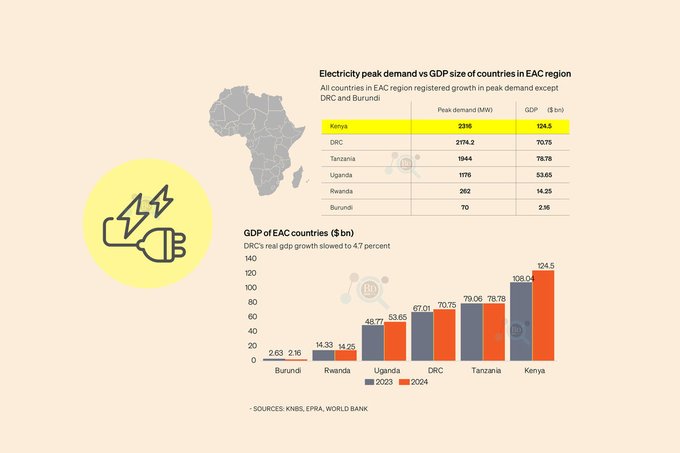

Kenya has emerged as the leading country in electricity access and consumption across the East African Community (EAC) region, underscoring its strong economic performance and growing energy demand.
According to data from the Kenya National Bureau of Statistics (KNBS), the Energy and Petroleum Regulatory Authority (EPRA) and the World Bank, Kenya recorded the highest electricity peak demand in the region at 2,316 megawatts (MW).
The report shows that all EAC member countries registered growth in electricity demand, except the Democratic Republic of Congo (DRC) and Burundi.
Tanzania followed with a peak demand of 1,944 MW, while Uganda stood at 1,176 MW.
Rwanda and Burundi recorded lower demands of 262 MW and 70 MW, respectively.
The figures indicate that Kenya’s electricity usage is closely tied to its expanding economy, which remains the largest in the EAC.
The country’s gross domestic product (GDP) is projected to reach $124.5 billion in 2024, up from $108.4 billion in 2023.
The rise in power consumption is attributed to the increased industrialization, infrastructure growth, and improved household access to electricity.
Kenya’s sustained investment in renewable energy sources such as geothermal, wind, and solar has also contributed to its strong performance.
By comparison, Tanzania’s GDP is expected to grow from $78.8 billion to $79.06 billion, while Uganda’s economy will expand from $53.65 billion to $67.01 billion.
Rwanda and Burundi trail at $14.33 billion and $2.63 billion, respectively.
Despite having one of the largest populations and vast natural resources, the DRC recorded a drop in power demand, registering 2,174 MW.
The country’s real GDP growth also slowed to 4.7 percent, highlighting structural challenges in its energy and industrial sectors.
Kenya’s leadership in both energy demand and GDP size points to a robust link between electricity access and economic productivity.
“All countries in the EAC region registered growth in peak demand except DRC and Burundi,” the report states, reflecting how energy use continues to mirror regional economic trends.
Kenya’s growing energy appetite is expected to push further investment into generation, transmission, and distribution infrastructure.
The government’s ongoing efforts to expand access to clean and reliable power have been instrumental in driving economic activity in both urban and rural areas.
The data underscores Kenya’s position as a regional economic powerhouse, supported by strong performance in key sectors such as manufacturing, transport, and services, all of which rely heavily on electricity.
However, Kenya’s progress remains unmatched, driven by policy consistency and innovation in the energy sector.
As the report concludes, Kenya’s energy and economic trajectory “reflects the growing interdependence between power consumption and GDP growth” in East Africa.













